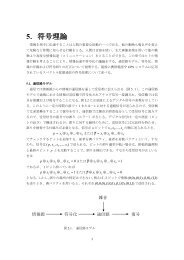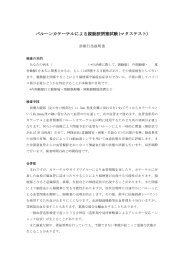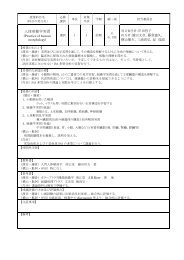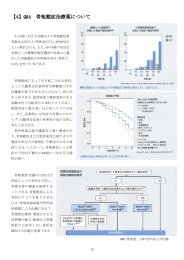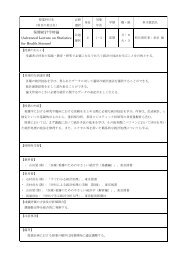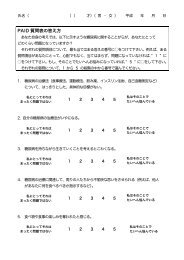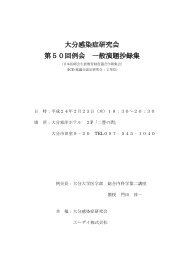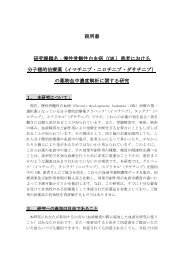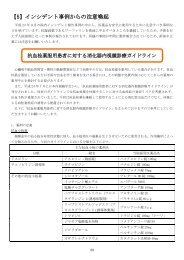REVIEWSBox 2 | The properties <strong>of</strong> important protein ligands for <strong>fibulins</strong>Fibronectin is an important micr<strong>of</strong>ibrillar protein. It is an elongated (61 nm)disulphide-linked homodimer <strong>of</strong> 450 kDa, which consists <strong>of</strong> unique fibronectin type I(F1), F2 and F3 modules that have various binding properties.Laminins are heterotrimers (αβγ) <strong>of</strong> α1–α5, β1–β3 and γ1–γ3 chains in variouscombinations and they have molecular masses <strong>of</strong> 400–750 kDa. Principal domainsinclude the laminin G-type (LG)1–LG5 modules at the carboxyl terminus <strong>of</strong> theα-chains and numerous laminin-type epidermal growth factor (EGF)-like (LE)modules that are related to EGF-like domains. Laminins have a cross-like shape(36–77 nm along their short and long arms) and they form important networkstructures in basement membranes.Perlecan is an important proteoglycan <strong>of</strong> basement membranes and <strong>of</strong> other<strong>extracellular</strong> <strong>matrix</strong> structures, and it consists <strong>of</strong> an elongated (80 nm) core protein<strong>of</strong> 480 kDa, which is modified by 3–4 heparan sulphate chains. It has amultidomain structure and is composed <strong>of</strong> LG, LE, EGF-like and immunoglobulinlikemodules.Nidogen is a ubiquitous basement-membrane protein <strong>of</strong> 150 kDa. It consists <strong>of</strong> threeglobular domains (G1–G3) that have high binding affinities for laminins, perlecan andcollagen IV.RGD-DEPENDENT INTEGRINSA specific group <strong>of</strong> cellularintegrin receptors that bind tothe arginine-glycine-aspartate(RGD) sequences <strong>of</strong> theirligands.WERNER SYNDROMEA premature ageing disorderthat is inherited in an autosomalrecessive mode. The clinicalsymptoms can include shortstature, wrinkled skin, baldness,cataracts and muscular atrophy.SYNPOLYDACTYLYA developmental defect that ischaracterized by the fusion(syndactyly) and splitting(polydactyly) <strong>of</strong> fingers or toes.It is usually an autosomaldominant disease and can resultfrom mutations in thehomeobox genes.Effects on cellular activitiesInteractions with integrins. Because <strong>of</strong> their broadoccurrence in the ECM, several <strong>of</strong> the <strong>fibulins</strong> were alsostudied for their ability to promote integrin-mediatedcell adhesion and migration. Mouse fibulin-2 wasshown to bind to purified platelet αIIbβ3 and αvβ3,which are both RGD-DEPENDENT INTEGRINS, and this interactionwas confirmed in adhesion assays with activatedplatelets and other cells 67 . The RGD sequence in the Ndomain <strong>of</strong> mouse fibulin-2 was shown to be involved inthis interaction, but this RGD sequence is not conservedin human fibulin-2, which still binds the αIIbβ3 integrin.Together, the data indicate that there is a role forfibulin-2 in haemostatic control. Fibulin-1 lacks RGDsequences and had no activity in cell-adhesionassays 67,68 . However, fibulin-1 inhibited cell adhesion to,and migration on, fibronectin. The binding <strong>of</strong> fibulin-1does not, however, block the integrin-binding sites <strong>of</strong>fibronectin, which led to the proposal that the formation<strong>of</strong> this complex generates a new anti-adhesive site,which repulses cellular interactions rather than promotesthem 68 . Finally, a single RGD site in the aminoterminaldomain I <strong>of</strong> fibulin-5 has also been shown tobe cell adhesive, and it interacts, in particular, withαvβ3, αvβ5 and α9β1 integrins 22,69 .Effect on cell proliferation. There is an increasingamount <strong>of</strong> data that indicate that most <strong>fibulins</strong> havethe ability to interfere with several cellular activities,and these data were interpeted to reflect their control<strong>of</strong> cellular proliferation and malignant transformation.Most <strong>of</strong> these data are, however, preliminary and, inpart, controversial, and no general concept hasemerged for their interpretation. This is perhaps bestillustrated by a recent study on fibulin-5, which cameto the conclusion that regulation occurs in a contextspecificmanner and depends on the cell type and assayconditions used 70 .The first evidence for a cellular proliferation activitywas described for fibulin-3, which is upregulatedin senescent and WERNER SYNDROME fibroblasts, as wellas in quiescent young fibroblasts 14 . This indicated thatthere was an effect on DNA synthesis, but the datahave so far remained controversial. A similar changein quiescent fibroblasts has also been reported forfibulin-4 (REF. 10), although fibulin-4 has also beenshown to stimulate growth 71 . A few further interestingactivities have been reported for fibulin-1, which,as already discussed, include modulation <strong>of</strong> neuriteoutgrowth through binding to APP 35 , the binding <strong>of</strong>growth factors such as CTGF 66 , and the regulation <strong>of</strong>signal transduction by inhibiting the phosphorylation<strong>of</strong> the <strong>extracellular</strong>-signal-regulated kinase(ERK) 68 . The latter activity is also shared by fibulin-5(REF. 70). The cellular receptors that are involvedremain to be identified.Effect on malignant transformation. A variable set <strong>of</strong>data has indicated that there is a correlation betweenfibulin expression and certain types <strong>of</strong> malignant cells,and these data were interpreted to indicate that there is arole for <strong>fibulins</strong> in tumour suppression 70,72 . These correlationsinclude an upregulation <strong>of</strong> fibulin-4 in colon carcinomas15 and <strong>of</strong> fibulin-1 in ovarian carcinomas 44,73 .This upregulation might inhibit the mobility <strong>of</strong> cancercells, which would suppress their invasiveness 74 .Themost interesting observation, however, is that high concentrations<strong>of</strong> the fibulin-1D variant selectively delaytumour transformation and invasive potential 72 .Themechanism is still unclear, but this indicates that there isa specific binding function for fibulin-1D that is notshared by fibulin-1C. This specific-binding function forfibulin-1D is also indicated by genetic evidence (seebelow), but remains to be defined.Genetic evidence for biological functionInsights into the in vivo functions <strong>of</strong> several <strong>fibulins</strong>have emerged from the identification <strong>of</strong> human diseasesthat involve fibulin loci and from the analysis <strong>of</strong> genetargetedmutant mouse strains. Targeted inactivation <strong>of</strong>the fibulin-1 gene in mice (Fbln1) leads to severe haemorrhagesin skin, muscle and perineural tissues, whichstart from midgestation and result in the death <strong>of</strong>almost all homozygous embryos at birth 65 . The defect iscaused by ruptures in the endothelial lining <strong>of</strong> small, butnot large, blood vessels. Capillary endothelial cells in theFbln1-null mice have very irregular cytoplasmicprocesses, but the underlying basement membrane isintact. Further defects were found in the kidneys andlungs, which might also contribute to the lethal phenotype.The mouse model therefore indicates that fibulin-1is important in the stabilization <strong>of</strong> blood vessel wallsand that it is also involved in diverse biological processesduring embryogenesis.Fibulin-1 has also been implicated in limb malformations.Three patients in a <strong>family</strong> affected with acomplex type <strong>of</strong> SYNPOLYDACTYLY have been found tocarry a balanced chromosomal translocation thatinvolves an alternatively spliced exon <strong>of</strong> FBLN1 and agene <strong>of</strong> unknown function that is located on the shortarm <strong>of</strong> chromosome 12 (REF. 75). This results in reduced486 | JUNE 2003 | VOLUME 4 www.nature.com/reviews/molcellbio© 2003 Nature PublishingGroup
REVIEWSTable 3 | The binding properties <strong>of</strong> fibulin-1 and fibulin-2 for <strong>extracellular</strong> <strong>proteins</strong>Interacting ligand Affinity (K d)* Calcium dependence ‡ Epitope mapped ReferencesFibulin-1Fibronectin 139 nM + Yes 19,45,46Nidogen-1 2–60 nM + Yes 19,50Laminin-1 80 nM + Yes 19Fibrinogen 3 µM ND Yes 63Aggregan, versican 10–30 nM + Yes 61Tropoelastin 18 nM + No 37Endostatin 46 nM – No 57Laminin γ2 chain 20 nM ND Yes 56Laminin α2 chain 14 nM ND Yes 54Connective-tissue growth factor ND ND Yes 66β-amyloid precursor protein ND + Yes 35Fibulin-2Fibronectin 1 µM + Yes 7Nidogen-1 0.5 µM – No 7Perlecan 22 nM ND Yes 52Fibrillin-1 56 nM + Yes 36Tropoelastin 0.6 nM + Yes 37Endostatin 33 nM – No 57Aggrecan, versican 0.1 nM + Yes 62Laminin γ2 chain 20–40 nM ND Yes 56Laminin α2 chain 13 nM ND Yes 54*The affinities were determined using surface plasmon resonance. ‡ The calcium dependence was examined by the addition <strong>of</strong> EDTA.ND, not determined.MACULAR DEGENERATIVEDISEASEAn incurable eye disease that iscaused by the deterioration <strong>of</strong>the central portion <strong>of</strong> the retina,which is known as the macula.The disease is heterogeneousand includes the rare heritableforms, the sporadic early-onsetform and the age-related form.expression <strong>of</strong> the D, but not the C, variant <strong>of</strong> fibulin-1in patients’ fibroblasts. As fibulin-1 is expressed in thedigits <strong>of</strong> the developing limb, altering the expression <strong>of</strong>fibulin-1 splice variants is thought to be responsiblefor the digit abnormality 75 . This possibility, however,remains to be tested.As a result <strong>of</strong> positional cloning, a single mutationin the fibulin-3 gene (FBLN3), which results in anR345W substitution (where W is tryptophan), wasfound to be the cause <strong>of</strong> two inherited forms <strong>of</strong> MACULARDEGENERATIVE DISEASE — so-called Malattia Leventineseand Doyne honeycomb retinal dystrophy 21 . Maculardegenerative disease is characterized by <strong>extracellular</strong>deposits, which are known as drusen, beneath theretinal pigment epithelium. R345 is located in the lastcbEGF-like domain <strong>of</strong> fibulin-3 and follows the secondcysteine residue. Interestingly, this mutation infibulin-3 was found in 161 patients from 37 familiesin the initial study, although recent evidence indicatesthat there is molecular heterogeneity within theinherited forms <strong>of</strong> macular degenerations 76 .Mutations in fibulin-3 are not associated with thesporadic form <strong>of</strong> early onset drusen or with agerelatedmacular degeneration, which is the mostcommon cause <strong>of</strong> blindness and is also characterizedby drusen deposition 21 . In both inherited and agerelatedmacular degeneration diseases, fibulin-3 isnot located at the site <strong>of</strong> drusen formation, but is aberrantlyaccumulated with and/or beneath the retinalpigment epithelium 77 . A R345W mutant fibulin-3protein produced by a mammalian expression systemis misfolded, secreted inefficiently and retained incells 77 . It has therefore been postulated that the misfoldingand aberrant accumulation <strong>of</strong> fibulin-3 mighthave a role in the etiology <strong>of</strong> macular degeneration 77 .An essential role for fibulin-5 in elastic-fibre assemblyin vivo was highlighted by the abnormal phenotypes<strong>of</strong> mice lacking fibulin-5 (REFS 22,23). The mutantmice showed markedly disrupted and disorganizedelastic fibres, which resulted in loose skin, emphysematouslungs and tortuous aortas with loss <strong>of</strong> function.Fibulin-5, which is expressed in tissues that areenriched in elastic fibres and binds tropoelastin andcell-surface integrins in vitro, is thought to anchor elasticfibres to cells and to be required for elastic-fibreassembly during development. It has also been postulatedthat fibulin-5 might function as a chaperone thattethers tropoelastin to the cell surface during elasticfibreassembly 78 .Although Fbln5-null mice have highly disorganizedelastic fibres in their internal organs, they survive toadulthood. The phenotypes <strong>of</strong> the mutant mice resemblethose <strong>of</strong> human patients with cutis laxa — a heterogeneousgroup <strong>of</strong> disorders that are characterized byloose skin and that have variable internal-organ involvement,such as pulmonary emphysema and cardiovascularabnormalities. This phenotype similarity led to theidentification <strong>of</strong> a homozygous missense mutationNATURE REVIEWS | MOLECULAR CELL BIOLOGY VOLUME 4 | JUNE 2003 | 487© 2003 Nature PublishingGroup



